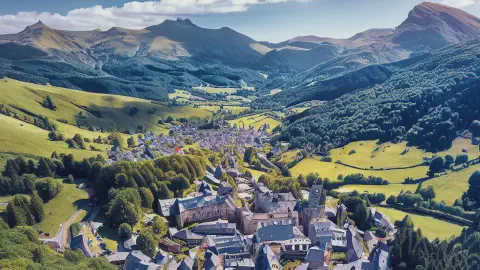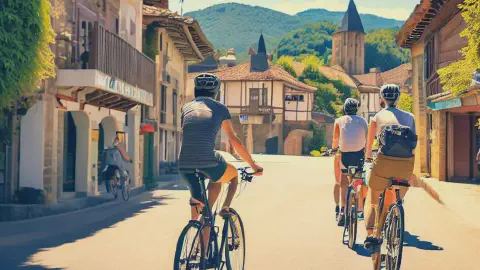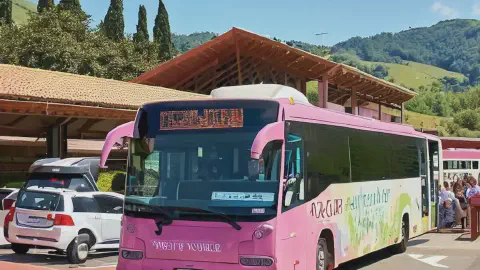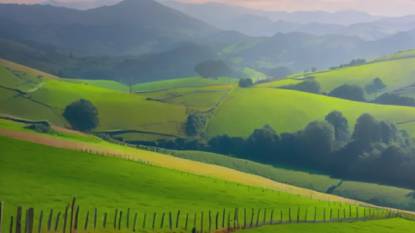
Camino Francés: Roncesvalles to Zubiri - Stage 2
Posted: | Updated:
Reading time: 12 minutes
Camino Francés: Roncesvalles to Zubiri - Stage 2
Posted: | Updated:
Reading time: 12 minutes
By: Simon Kemp, Editor
Stage 2 of the Camino Francés takes pilgrims on a scenic journey through the Pyrenees from Roncesvalles to Zubiri. This 22 km stretch presents unique challenges, from steep climbs to rocky descents. However, the beautiful landscape and historic landmarks along the way make this stage a memorable part of the journey. In this article, we’ll provide a detailed route description of stage 2 to help you prepare for your Camino adventure.
The Camino Francés continues its journey from Roncesvalles, a historic village in Navarre, Spain, to Zubiri, a charming town in the Basque Country. This stage offers pilgrims a mix of forested trails, rolling hills, and a descent into the valley of the Rio Arga, making it a scenic and rewarding walk.
Historical Background
- Roncesvalles: Known for its medieval monastery, Roncesvalles has been a key stop for pilgrims since the Middle Ages. It is also famous for the Battle of Roncevaux Pass (778 AD), where Charlemagne’s army suffered a historic defeat.
- Zubiri: This small town is known as the “town of the bridge” due to its iconic Puente de la Rabia, a medieval bridge over the Rio Arga. According to legend, the bridge was believed to cure rabies in animals that crossed it.
The Camino Route
The journey from Roncesvalles to Zubiri spans approximately 21.5 km and is characterized by:
- Forested paths through the lower Pyrenees.
- Gradual descents with some steep sections, particularly near Zubiri.
- Scenic villages like Burguete and Espinal, offering rest stops and refreshments.
- Rio Arga, a beautiful river that runs through Zubiri, marking the end of this stage.
This stage is considered moderately challenging, with a mix of trails and paved roads. Pilgrims often find it to be one of the most picturesque sections of the Camino, offering a transition from the rugged Pyrenees into the rolling landscapes of Navarre.
Roncesvalles to Zubiri Route Map
Departure point: Roncesvalles
Nestled in the stunning Pyrenees mountains of northern Spain, Roncesvalles is a small village that serves as an important stop on the Camino Francés pilgrimage route to Santiago de Compostela. The village has a rich history and offers a range of attractions and services for visitors.
Location and History
Roncesvalles is situated in the Navarre region of northern Spain, near the border with France. The village is at the foot of the Pyrenees mountains and is surrounded by breathtaking natural scenery, making it a popular destination for hikers and nature lovers. Roncesvalles has a fascinating history that dates back to the Middle Ages when it was a crucial stop on the Camino de Santiago pilgrimage route. The village was also the site of a famous battle in 778 AD, where Charlemagne’s army clashed with a Basque force.
Points of Interest
Roncesvalles offers numerous attractions for visitors. One of the most notable is the Collegiate Church of Roncesvalles, an impressive Gothic-style church that dates back to the 12th century. The church is home to a museum that contains many artifacts related to the history of the village and the Camino de Santiago pilgrimage. Visitors can also explore the village’s historic center, which is characterized by narrow streets, traditional Basque architecture, and stunning views of the surrounding landscapes. The village is also an excellent starting point for hiking and outdoor activities, including the popular Camino de Santiago pilgrimage route.
Camino-related Services
As a stop on the Camino Francés pilgrimage route, Roncesvalles offers a range of services and amenities for pilgrims. Accommodation options include hostels and hotels, with many specifically catering to pilgrims. Visitors can indulge in delicious Basque cuisine at local restaurants and cafes, including pintxos (small snacks typically eaten with drinks) and hearty stews. Shops selling souvenirs and other essentials are also available. Medical facilities, pharmacies, and other essential services are also available for pilgrims, making it a convenient and practical destination.
Roncesvalles is a charming village that offers a unique and memorable experience for visitors. Its location in the stunning Pyrenees, rich history, and range of attractions and services make it a popular destination for both pilgrims and tourists. Whether you’re interested in exploring the historic center of the village, hiking in the surrounding mountains, or simply soaking up the natural beauty of the region, Roncesvalles is a destination that is definitely worth visiting.
Roncesvalles to Zubiri Route Description
The second stage of the Camino Francés takes pilgrims on a journey from Roncesvalles to Zubiri, spanning a distance of approximately 20 km. This stage is considered challenging due to the hilly terrain and changes in elevation. Here is a detailed route description of this stage:
Route Description
The stage begins in Roncesvalles, a small town located in the Pyrenees Mountains. The initial part of the stage is an ascent through the woods of the mountain, with some steep inclines to be expected.
After approximately 4 km of uphill walking, pilgrims will reach the highest point of the stage, known as Alto de Erro. This section of the route offers stunning views of the surrounding mountainous landscape.
From this point on, the route begins to descend towards the town of Zubiri. Pilgrims will continue along the path, which becomes more gentle and undulating, passing through small hamlets and picturesque countryside.
The final descent into Zubiri is particularly steep and can be challenging for tired legs. Pilgrims will reach the town center by crossing a medieval bridge over the river Arga.
Terrain and Difficulty
The terrain on this stage is varied, with the first section being the most challenging due to the steep ascent. The route follows forest paths, farm tracks, and rural roads, with some sections being rocky and uneven.
The overall difficulty level of this stage is considered moderate to difficult due to the steep inclines, changes in elevation, and rocky terrain. Pilgrims should take care when walking and ensure they have appropriate footwear and equipment.

Key Landmarks and Points of Interest
- Roncesvalles: This small town is the starting point of the stage and is home to a beautiful Gothic church and a 12th-century monastery.
- Alto de Erro: The highest point of this Roncesvalles to Zubiri stage of the Camino Francés, offering stunning panoramic views of the Pyrenees Mountains.
- Zubiri: A picturesque town situated on the river Arga. Points of interest include the medieval bridge, church of San Martín, and traditional Basque architecture.
The second stage of the Camino Francés offers a challenging yet rewarding journey through the Pyrenees Mountains. With stunning views and picturesque countryside, this stage is a beautiful experience for pilgrims. However, it is important to take care when walking and ensure appropriate equipment is used to ensure a safe and enjoyable journey.
Destination: Zubiri
Zubiri is a small town in the Navarre region of northern Spain. The town is located about 20 kilometers from Pamplona and is situated on the Camino Francés pilgrimage route to Santiago de Compostela. The town’s name comes from the Basque language, and it means “town of the bridge”. Zubiri has a rich history and offers a range of attractions and services for visitors. The official guide lists Larrasoaña as the destination but most people try to get from Zubiri to Pamplona the following day.
Location and History
Zubiri is located in the province of Navarre, in northern Spain. The town is situated on the banks of the River Arga, which flows through the town center. Zubiri has a long history, dating back to the Roman era when it was a strategic location for controlling trade routes. Over the centuries, the town has been occupied by various groups, including the Moors and the French during the Napoleonic Wars.
One of the most significant events in the town’s history was the Battle of Zubiri, which took place in 1834 during the First Carlist War. The battle was fought between the forces of the Spanish government and the Carlists, who sought to restore the absolute monarchy in Spain. Although the battle was relatively small, it was a significant victory for the Carlists, and it helped to prolong the war for several years.
Points of Interest
Zubiri offers several points of interest for visitors. One of the most notable is the medieval bridge that spans the River Arga. The bridge, known as the Puente de la Rabia, dates back to the 12th century and was an important crossing point for pilgrims on the Camino de Santiago. The bridge is a remarkable example of medieval engineering and has survived several floods and storms over the centuries.
The town also has several historic buildings, including the Church of San Esteban, which was built in the 13th century. The church is a beautiful example of Romanesque architecture, with a simple but elegant design. The church’s bell tower is particularly noteworthy, with a unique octagonal shape and intricate stone carvings.
The town center is characterized by narrow streets and traditional Basque architecture, with many buildings featuring colorful facades and balconies. Visitors can also explore the town’s main square, Plaza de la Constitución, which is a popular meeting place for locals and tourists alike. The square is surrounded by cafes and restaurants, making it an excellent place to relax and enjoy some of the region’s delicious cuisine.
Camino-related Services
As a stop on the Camino Francés, Zubiri offers a range of services and amenities for pilgrims. Accommodation options include hostels and hotels, with many specifically catering to pilgrims. The town has several shops selling supplies for the Camino, including walking poles, clothing, and maps. Medical facilities, pharmacies, and other essential services are also available for pilgrims.

Outdoor Activities
Zubiri is a popular destination for outdoor activities, including hiking and cycling. The town is situated on the edge of the Pyrenees and offers several hiking trails, including a section of the Camino de Santiago. The River Arga is also popular for kayaking and fishing. Visitors can rent kayaks and canoes in the town center and explore the river and its surrounding landscapes.
Zubiri is a charming town with a rich history and a range of attractions and services for visitors. Whether you’re a pilgrim on the Camino de Santiago or a tourist exploring the region, Zubiri is a destination that is worth visiting. The town’s medieval bridge, historic buildings, and traditional Basque architecture offer a glimpse into the region’s past, while its outdoor activities and modern amenities make it a practical and enjoyable place
Travel Options from Roncesvalles to Zubiri
The picturesque journey from Roncesvalles to Zubiri is a highlight for pilgrims on the Camino Francés. This article provides an overview of the travel options available for traversing this beautiful stretch of the Camino de Santiago. Whether you prefer walking, cycling, or other modes of transportation, there are several ways to enjoy this scenic route.
- Walking the Camino:
The most popular and traditional choice is to walk the Camino from Roncesvalles to Zubiri. This 20-kilometer stage offers a challenging yet rewarding experience. Pilgrims can immerse themselves in the natural beauty of the Pyrenees, pass through charming villages, and witness stunning landscapes. It is advisable to plan for a full day of walking and carry essential supplies such as water, snacks, and comfortable walking shoes. - Cycling:
For those seeking an alternative to walking, cycling is a fantastic option. The Camino Francés provides designated cycling routes, allowing cyclists to cover the distance between Roncesvalles and Zubiri at their own pace. Cyclists can rent bikes in Roncesvalles or bring their own. It is important to follow the Camino regulations for cyclists and exercise caution while sharing the path with walkers. - Public Transportation:
If time constraints or physical limitations make walking or cycling challenging, public transportation offers a convenient way to travel from Roncesvalles to Zubiri. Buses and taxis are available in Roncesvalles, providing transportation to Zubiri and other towns along the route. Check the local bus schedules and make sure to plan your trip in advance. - Guided Tours:
Joining a guided tour is an excellent option for those who prefer a structured and organized experience. Numerous tour operators specialize in leading groups along the Camino de Santiago. These tours often provide transportation, accommodation, meals, and knowledgeable guides who can offer insights into the history and culture of the region. Consider researching and booking a reputable tour operator in advance. - Car Rental:
If you prefer the flexibility of exploring the route at your own pace, renting a car is a viable option. Renting a car in Roncesvalles allows you to drive to Zubiri and explore other nearby attractions at your leisure. Keep in mind that parking may be limited in certain areas, and driving on narrow, winding roads requires caution.

How to Get From Roncesvalles to Zubiri by Bus
To travel from Roncesvalles to Zubiri by bus, you have a few options available. Here’s a detailed guide on how to make this journey:
- Bus Service:
The main bus service that operates in this region is the “La Baztanesa” bus company. They provide regular bus connections between Roncesvalles and Zubiri. This service is specifically designed to cater to pilgrims on the Camino de Santiago. - Bus Schedule:
The bus schedule may vary depending on the time of year, so it’s advisable to check the current schedule before your trip. You can visit the official website of “La Baztanesa” or contact their customer service for the most up-to-date information. - Departure Point:
In Roncesvalles, the bus departs from the main street near the Pilgrim’s Office. You can easily locate the bus stop as it is commonly used by pilgrims and marked with signs indicating the bus service. - Ticket Purchase:
Tickets can be purchased directly from the bus driver upon boarding. It’s recommended to have cash on hand as some buses may not accept credit cards. The ticket fare is typically affordable and reasonably priced. - Journey Duration:
The journey from Roncesvalles to Zubiri takes approximately 30 minutes by bus. However, this duration may vary based on traffic conditions and the specific bus schedule. It’s advisable to arrive at the bus stop a few minutes before the scheduled departure time to ensure a seat. - Arrival in Zubiri:
The bus will drop you off at the central bus stop in Zubiri. From there, you can easily access the town’s amenities, accommodations, and explore its attractions. - Return Journey:
If you plan to return from Zubiri to Roncesvalles by bus, you can follow the same steps outlined above, but in the opposite direction. Check the bus schedule for the return journey to ensure you have the necessary information.
It’s important to note that bus schedules and services are subject to change. Therefore, it’s always a good idea to double-check the schedule closer to your travel date and be prepared for any updates or adjustments. Additionally, it’s advisable to have some flexibility in your itinerary in case of unexpected changes to the bus service.
By following these guidelines, you should be able to travel comfortably and conveniently from Roncesvalles to Zubiri by bus. Enjoy your journey along the Camino de Santiago!

